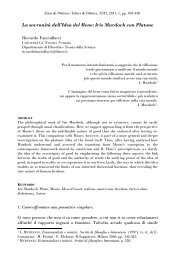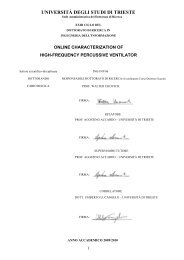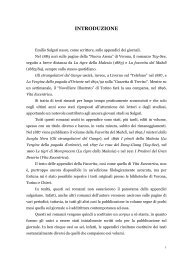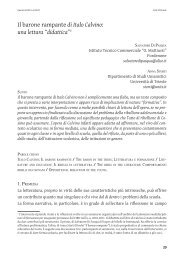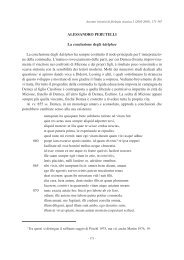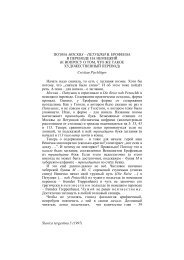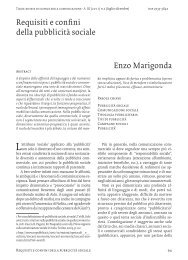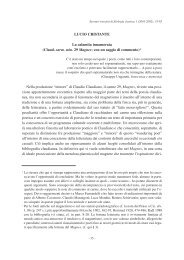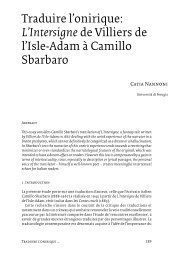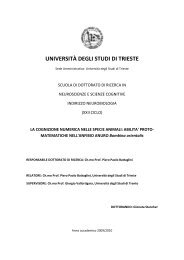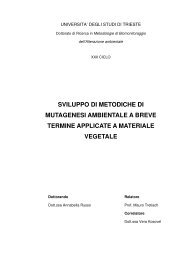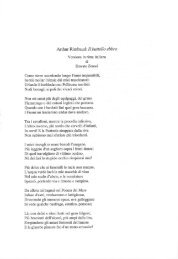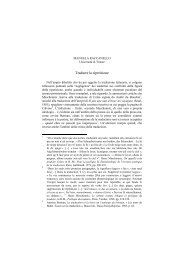Horizontal denominative variation in an EU victim ... - OpenstarTs
Horizontal denominative variation in an EU victim ... - OpenstarTs
Horizontal denominative variation in an EU victim ... - OpenstarTs
Create successful ePaper yourself
Turn your PDF publications into a flip-book with our unique Google optimized e-Paper software.
3 From polysemy <strong>an</strong>d synonymy to <strong>denom<strong>in</strong>ative</strong> <strong>variation</strong><br />
In the previous section the shift from traditional, polysemiophobic <strong>an</strong>d<br />
homonymiphobic term<strong>in</strong>ological approach (cf. Temmerm<strong>an</strong> 2000: 68) towards<br />
different real l<strong>an</strong>guage-oriented perspectives has been outl<strong>in</strong>ed very briefly. It<br />
goes without say<strong>in</strong>g that, based on the evidence provided above, term<strong>in</strong>ological<br />
<strong>variation</strong> is nowadays a well-known phenomenon, r<strong>an</strong>g<strong>in</strong>g from morphological<br />
<strong>an</strong>d morpho-syntactic to sem<strong>an</strong>tic <strong>variation</strong>: the purpose of the present study is<br />
to give further evidence of the existence of a specific aspect of term<strong>in</strong>ological<br />
<strong>variation</strong>, namely <strong>denom<strong>in</strong>ative</strong> <strong>variation</strong>.<br />
Before exam<strong>in</strong><strong>in</strong>g the m<strong>an</strong>ifestation of this l<strong>in</strong>guistic phenomenon <strong>in</strong> real<br />
communication, it is necessary to def<strong>in</strong>e the terms term<strong>in</strong>ological <strong>variation</strong> <strong>an</strong>d<br />
denotative <strong>variation</strong>. One of the first authors to deal with the concept of term<strong>in</strong>ological<br />
<strong>variation</strong> <strong>in</strong> French is Corbeil, accord<strong>in</strong>g to whom term<strong>in</strong>ological <strong>variation</strong><br />
comprises both synonymy, which he calls “concurrence term<strong>in</strong>ologique”<br />
(Corbeil 1988: 57, cited <strong>in</strong> Freixa 2002: 53), <strong>an</strong>d polysemy. Almost a decade later,<br />
Daille et al. (1996: 201) provided the follow<strong>in</strong>g def<strong>in</strong>ition: “a vari<strong>an</strong>t of a term is<br />
<strong>an</strong> utter<strong>an</strong>ce which is sem<strong>an</strong>tically <strong>an</strong>d conceptually related to <strong>an</strong> orig<strong>in</strong>al<br />
term”. In their view, a vari<strong>an</strong>t is therefore <strong>an</strong>y attested form of a designation of a<br />
specific concept encountered <strong>in</strong> a text, different from <strong>an</strong> authorized term listed<br />
<strong>in</strong> <strong>an</strong> authoritative resource <strong>an</strong>d reflect<strong>in</strong>g a different degree of sem<strong>an</strong>tic or<br />
conceptual identity or dist<strong>an</strong>ce with the “orig<strong>in</strong>al” term. Consequently, the def<strong>in</strong>ition<br />
proposed by Daille et al. differs from Corbeil’s as term<strong>in</strong>ological <strong>variation</strong>,<br />
apart from synonymy <strong>an</strong>d polysemy, also <strong>in</strong>cludes cases of hypernymy <strong>an</strong>d<br />
hyponymy.<br />
In our view, term<strong>in</strong>ological <strong>variation</strong> should be <strong>in</strong>tended accord<strong>in</strong>g to Freixa’s<br />
broad def<strong>in</strong>ition “la variació que afecta els termes” (2002: 54). Provided that the<br />
existence of term<strong>in</strong>ological units is based on both semiotic or l<strong>in</strong>guistic <strong>an</strong>d<br />
conceptual aspects, we c<strong>an</strong> therefore assume that term<strong>in</strong>ological <strong>variation</strong><br />
<strong>in</strong>cludes two types of <strong>variation</strong>: <strong>denom<strong>in</strong>ative</strong> <strong>variation</strong>, def<strong>in</strong>ed by Freixa as “el<br />
fenomen pel qual a una mateixa noció li corresponen diverses denom<strong>in</strong>acions”,<br />
<strong>an</strong>d conceptual <strong>variation</strong>, me<strong>an</strong><strong>in</strong>g “variació en un mateix concepte” (Freixa 2002:<br />
54). The preference for the term <strong>denom<strong>in</strong>ative</strong> <strong>variation</strong>, further def<strong>in</strong>ed by the<br />
same author as “the phenomenon <strong>in</strong> which one <strong>an</strong>d the same concept has different<br />
denom<strong>in</strong>ations; […] restricted to <strong>variation</strong> among different denom<strong>in</strong>ations,<br />
i.e., lexicalized forms, with a m<strong>in</strong>imum of stability <strong>an</strong>d consensus among<br />
the users of units <strong>in</strong> a specialized doma<strong>in</strong>” (Freixa 2006: 51), over the term synonymy,<br />
is due to the purpose of avoid<strong>in</strong>g the much debated dist<strong>in</strong>ction between<br />
what is considered a proper synonym, i.e. a term designat<strong>in</strong>g the same concept<br />
as <strong>an</strong>other term <strong>in</strong> which one or more lexical elements constitut<strong>in</strong>g the unit differ<br />
from the latter, <strong>an</strong>d vari<strong>an</strong>ts, which are usually identified with terms present<strong>in</strong>g<br />
syntactic, morphosyntactic, morphological or orthographical modifications<br />
(abbreviations, acronyms, presence/absence of articles <strong>in</strong> multiword<br />
terms etc.).<br />
180



